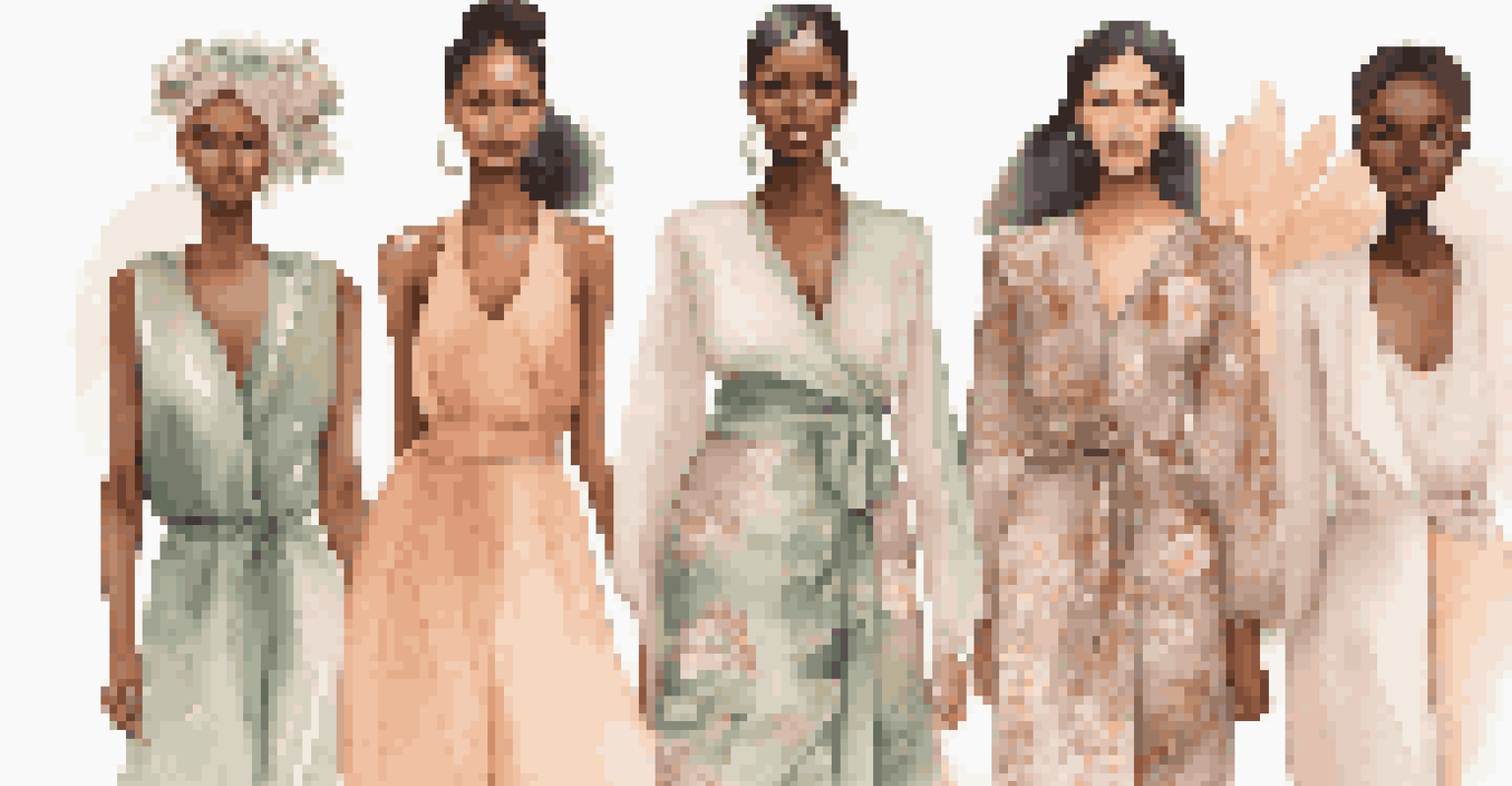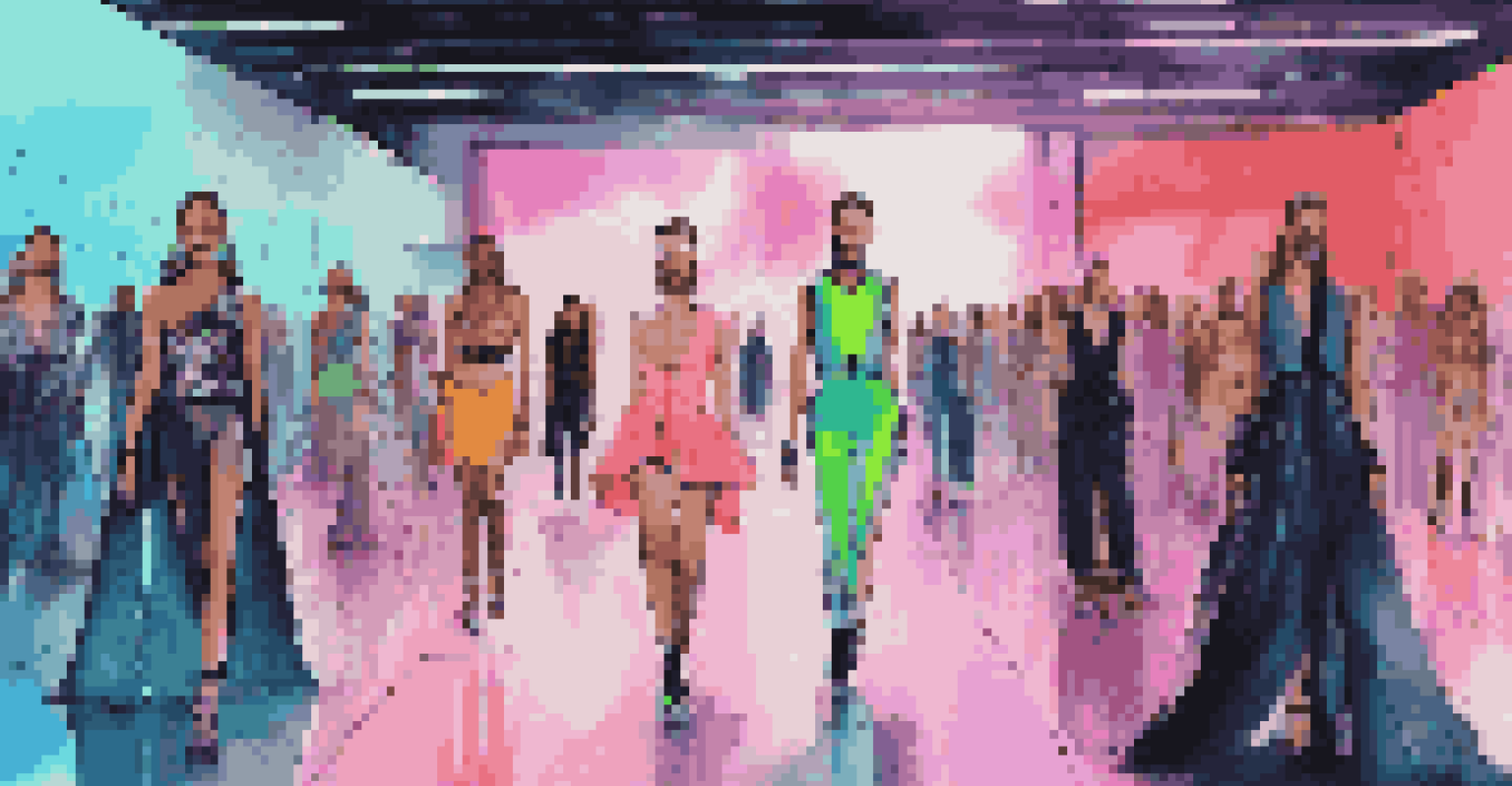The Evolution of Fashion Illustrators as Visual Artists

The Roots of Fashion Illustration in Historical Context
Fashion illustration has deep roots, tracing back to the 16th century when artists began depicting clothing styles in their works. These early illustrations served as a means to showcase the attire of the elite, often highlighting social status and cultural trends. Think of them as the Instagram posts of their time, capturing the essence of fashion for posterity.
Fashion is the armor to survive the reality of everyday life.
As time progressed, fashion illustrations became more than mere documentation; they evolved into an art form. Artists like Paul Poiret and later, the legendary Erté, transformed fashion illustration into a glamorous spectacle, showcasing not just clothes but the lifestyle that came with them. Their works were featured in magazines, reaching audiences far and wide, much like today’s viral fashion campaigns.
By the 20th century, fashion illustration had established itself as a vital component of the fashion industry. It became a bridge between designers and consumers, communicating trends and styles through visual storytelling. This era marked the beginning of a new relationship between fashion and art, where each influenced the other.
The Golden Age of Fashion Illustration
The 1920s to the 1950s are often referred to as the golden age of fashion illustration. During this time, publications like Vogue and Harper's Bazaar showcased the work of talented illustrators, making them household names. Artists such as Charles Dana Gibson and David Downton defined the aesthetic of their era, blending glamour with artistic finesse.

This period was characterized by the use of bold lines and vibrant colors, capturing the essence of the Jazz Age and beyond. Illustrators not only depicted clothing but also encapsulated the mood and spirit of the times, making their work a reflection of society as a whole. It was a time when fashion was not just about clothing but an expression of identity and freedom.
Evolution of Fashion Illustration
Fashion illustration has transformed from a means of documenting social status to an art form that influences and reflects contemporary culture.
As the world moved towards the mid-century, fashion illustrators began to experiment with new styles and techniques. The emergence of modernist influences led to more abstract representations, allowing for greater creativity and personal expression. This shift paved the way for a more diverse range of artistic interpretations within fashion illustration.
The Impact of Technology on Fashion Illustration
The late 20th century brought significant technological advancements that transformed the landscape of fashion illustration. The introduction of computers and digital software opened up new avenues for artists, allowing them to explore innovative techniques and styles. This shift was akin to moving from oil painting to digital art, expanding the artist's toolkit exponentially.
Illustration is the way to tell a story that cannot be told with words alone.
Illustrators began to blend traditional techniques with digital tools, resulting in a unique fusion of styles. The ability to manipulate images and colors with precision revolutionized the way fashion was presented. Illustrators could now create stunning visuals that were not only eye-catching but also versatile, ready to be shared across various platforms.
Moreover, technology democratized the field of fashion illustration. Aspiring artists could learn from online tutorials and showcase their work on social media, gaining exposure that was once reserved for a select few. This accessibility has led to a resurgence of interest in fashion illustration, as new voices and perspectives continue to emerge.
Emerging Trends in Fashion Illustration Today
In today's fast-paced fashion world, illustrators are exploring a variety of trends that reflect contemporary culture. From street style to sustainability, modern fashion illustrations are not only about aesthetics but also commentary on societal issues. Artists are using their platforms to advocate for change, making their work resonate on a deeper level.
Collaboration is another prominent trend, with illustrators teaming up with fashion brands, influencers, and even other artists. These partnerships often yield innovative collections that highlight the unique strengths of each contributor. This collaborative spirit mirrors the interconnectedness of the modern fashion ecosystem, where ideas flow freely across boundaries.
Impact of Technology and Social Media
Technological advancements and social media have democratized fashion illustration, allowing diverse voices to emerge and engage directly with audiences.
Furthermore, the rise of augmented reality (AR) and virtual reality (VR) is pushing the boundaries of how fashion illustrations are experienced. Brands are experimenting with interactive illustrations that allow consumers to engage with fashion in new and exciting ways. This evolution exemplifies the adaptive nature of fashion illustration as it continues to evolve with technological advancements.
The Role of Social Media in Fashion Illustration
Social media has played a transformative role in the world of fashion illustration, serving as a platform for artists to share their work and connect with audiences. Platforms like Instagram and Pinterest have become virtual galleries, showcasing the creativity of illustrators from around the globe. This accessibility has made it easier for emerging artists to gain visibility and build a following.
Moreover, social media allows illustrators to engage directly with their audience, creating a sense of community. Artists can share their creative process, receive feedback, and even collaborate with fans. This two-way interaction fosters a deeper appreciation for the art form and encourages innovation as artists respond to the preferences of their followers.
As a result, social media has not only democratized fashion illustration but has also influenced the style and themes that resonate with audiences. Trends can emerge overnight, and illustrators are often at the forefront of capturing these fleeting moments. This dynamic relationship between fashion and social media ensures that the art of illustration remains relevant in an ever-changing landscape.
Diversity and Representation in Fashion Illustration
The conversation around diversity and representation has become increasingly important in the fashion industry, and fashion illustration is no exception. Artists are now embracing a broader range of body types, ethnicities, and styles in their work, challenging traditional norms. This shift reflects a growing recognition that fashion is for everyone, and illustration should mirror that inclusivity.
Illustrators are using their art to tell diverse stories, celebrating cultures and identities that were previously marginalized. By showcasing a variety of perspectives, they enrich the narrative of fashion, making it more relatable to a wider audience. This evolution in representation is akin to a colorful tapestry, where each thread contributes to the overall beauty of the design.
Emphasis on Diversity and Sustainability
Fashion illustrators are increasingly embracing diversity in representation and focusing on sustainability, shaping the industry's future narratives.
As the demand for diversity continues to rise, fashion illustrators play a crucial role in shaping perceptions and promoting positive change within the industry. Through their art, they challenge stereotypes and encourage acceptance, ultimately paving the way for a more inclusive future in fashion. This movement not only empowers artists but also inspires consumers to embrace their own unique styles.
The Future of Fashion Illustration as an Art Form
Looking ahead, the future of fashion illustration appears bright and full of potential. As artists continue to experiment with new mediums and technologies, we can expect to see even more innovative approaches to fashion representation. The blending of traditional techniques with modern tools will likely lead to exciting new styles that capture the essence of our times.
Moreover, the increasing emphasis on sustainability in fashion will influence the themes and narratives explored by illustrators. Artists may focus on eco-friendly practices, ethical consumption, and the stories behind sustainable fashion choices. This shift not only reflects societal values but also positions fashion illustration as a medium for advocacy and awareness.

Ultimately, the evolution of fashion illustrators as visual artists is a testament to their resilience and adaptability. As they continue to navigate the changing landscape of fashion and art, these creatives will play a pivotal role in shaping the future of the industry. The journey of fashion illustration is far from over, and we can't wait to see where it leads next.